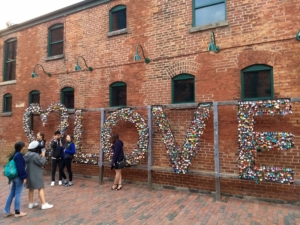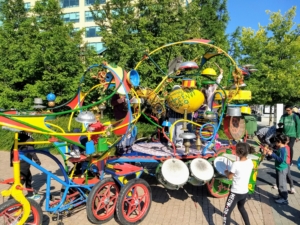By Eddie Pipkin
On a recent visit to Toronto’s harbor front, I saw two manifestations of interactive public art – one mobile, one permanent – that got me to thinking about the ways that churches can create communal  public spaces. Our church campuses are one of our most prominent resources, and they often occupy highly visible space in our neighborhoods, space that can be public and utilized as a gathering spot for all or space that can be classified as a “restricted area” for “members only.”
public spaces. Our church campuses are one of our most prominent resources, and they often occupy highly visible space in our neighborhoods, space that can be public and utilized as a gathering spot for all or space that can be classified as a “restricted area” for “members only.”
As for the things I saw in Toronto, the first was a permanent art installation, a metal sculpture of the word “Love” affixed to the side of a brick wall and constructed of wire mesh that was perfect for couples to hang padlocks on (as has been the romantic gesture on bridges all over the world in recent years). It was adorable, an d lots of people were stopping by to take pictures and check it out. It brought a sense of whimsy and social connection to what would have otherwise been a nondescript alley used for getting from point A to point B.
d lots of people were stopping by to take pictures and check it out. It brought a sense of whimsy and social connection to what would have otherwise been a nondescript alley used for getting from point A to point B.
The other thing was a giant, rolling musical instrument, multi-colored and composed of dozens of ways for kids to play percussion, like something straight out of the pages of a Dr. Seuss book. I have no idea what group was sponsoring its presence, but it was swarming with inquisitive kids who were having a grand time. Looking on were their parents, big smiles on their faces.
with inquisitive kids who were having a grand time. Looking on were their parents, big smiles on their faces.
Our church properties offer unlimited opportunities to create public spaces that are welcoming to all. They can be gathering points, community centers, and places of refuge and respite. Or we can hoard our facilities, restricting them to the exclusive use of OUR members and OUR programs. This is a basic philosophical choice for ministry asset deployment. It is, after all, a question of stewardship. What will we do with the resources available to us? Some of the very words used to visualize creative use of public space (“communal” gatherings, places to “congregate”) have direct faith connotations. Will we think of our church spaces fundamentally as “public” or “private”?
Many congregations share their classrooms and meeting spaces with community programs and support groups such as Boy Scouts, Girl Scouts, GriefShare, AA, and other recovery groups. Others have offered space for fitness groups, crafters, and senior citizen hangouts. The more of this we can do, the better. And some large, struggling, inner-city facilities have found new life by throwing open their doors to fill empty buildings with all manner of community groups. Sharing our interior spaces with outside groups (not just as a source for outside rental income) is a real indicator of community partnership.
There are many ways that church grounds can be used as public community space (and plenty of great ideas out there for getting more out of your church space, ways your church space can have a greater community impact, and ways to leverage your outdoor space):
- Meditative spaces. Lots of churches have meditative gardens, prayer gardens, memorial gardens, and reflective spaces. They are often located within courtyards or other areas that are well-known by church members but not positioned to be obvious for public use. Some churches — more frequently historic structures in urban areas – have beautiful church-adjacent parks that clearly welcome the neighborhood. Consider, even in suburban settings, how you might create reflective spaces that invite the community in. Use signage that reinforces the welcome! Prayer labyrinths are a popular way to create an inviting outdoor space that also signals a faith component.
- Recreational facilities. Many churches host practice and playing fields for all manner of sports. Some churches use these exclusively for their membership, but others invite in league teams for practice and competitions. (Restroom facilities are something to think about if you go this route.) Some churches have running paths, clearly public playgrounds, host outdoor fitness gatherings and local running or biking groups, even dog parks or disc golf courses or ropes courses.
- Art Galleries. Some churches make space available for local art exhibits. These can be seasonal displays, art shows, explorations of art and faith, or a partnership with local schools or colleges.
- Community use space. Rooms large and small can be made available to community group as noted earlier in the blog. Community special events and festivals can be hosted (or partnered with) on church property to great effect.
- Community gardens. Gardens for the purpose of growing food are a great option for local churches (and many have embraced this ministry). Sometimes the garden is tended by church members and the harvest supports a food pantry. Other times the garden is an “allocation garden,” and members of the community can sign up for plots that they tend themselves. Either of these strategies promotes environmental stewardship and healthy living and makes a strong visual statement to those who pass by.
- Concert venues. Music is already a big part of the life of most faith families, and church staff and music volunteers are often well-connected to the local music scene. Churches can be a great regular spot for musicians to play and locals to gather to experience music together.
- Parking to support nearby community events. Anytime a major civic celebration is at hand (parades, festivals, fireworks, etc.), the local church should try to integrate with what’s already happening to support it with people and resources, at least volunteering to serve as a location for satellite parking (and again, not just as a cash grab, charging people to park).
- Serve as an incubator for other non-profits. Some churches with large facilities are able to offer long-term space to support social justice start-ups. This is a powerful community engagement statement. But even smaller congregations can support shared non-profit workspace and resource collaboration.
I don’t mean to minimize the complications of taking a more “public” stance in the management of church facilities. There are legitimate issues involved. There is direct corollary between increased community engagement and greater logistical hassles: the more engagement, the more headaches for church staff. But that is the ethos of the Gospel, isn’t it? Self-sacrifice as a manifestation of love? A willingness to complicate out lives (personal and institutional) in the service of others? Church leadership, staff, and volunteers are eager to take on the complications of a more “open door” policy if that policy is clearly articulated as a vital part of the ministry mission. I knew of a church that was approached by the local recreational department about the possibility of hosting a once-a-month youth hangout and dance, but the church declined because they didn’t want to host a youth event that was exclusively managed by their youth program (a classic case of “what’s in it for us” and “this is just going to be a headache”-isms). To move beyond those parochial concerns to a broader embrace of community is a major ministry shift for most congregations.
Once we’ve decided the outcome is worth the effort, managing the logistical complications is doable. There are plenty of tools to assist, and consistent and clear policies streamline the process and guard against negative ramifications. There are concerns that will always be raised by well-intentioned committee members when discussing facility use by outside groups:
- Wear and tear on the facility or church-owned equipment. You do have to take this into account with responsible budget planning to allow for increased use. Either your congregation makes it a priority to invest in community engagement or you find ways for the community to partner in covering the costs. But I am firmly of the mindset that the reason we are entrusted with facilities and equipment is to use them for maximum ministry effect (not to preserve them pristinely for some future special purpose).
- Insurance considerations. It is important to be sure that you understand clearly – and those using your facilities understand clearly – the responsibilities and liabilities incurred in the use of shared space. For many local congregations, their denominational connections provide strong blanket coverage for virtually any use. If not, another investment in community engagement may be a strong umbrella policy. Sometimes, you may need to require certain higher risk groups (like sports leagues) to carry their own policies. The key is to research, have a plan in hand, and develop clear policies for dealing with issues. As always, clearer policies mean less drama.
- Legal liability. This point is, of course, directly linked to the one above, but broader in the sense that church leadership can become fixated on a defensive strategy that is a reaction to our litigious society. With proper insurance and policies in place, a legal issue is rare. It is an urban legend that churches are sued for substantial settlements regarding public use of their facilities.
- Safety. Obviously, safety has become an increasing concern for all ministries. Again, clear, thoughtful policies and procedures are necessary. Use common sense and best practices, but don’t let fears create an ostrich mentality (head in the sand, withdrawal from the community). I would add an obvious note here that for those churches affiliated with schools, there are very distinct standards for keeping those populations safe and secure, and those considerations should take priority during school hours.
Beyond the possibilities of on-campus community engagement, there are also opportunities to create portable projections of your church’s love for local residents. That’s why I also included the picture of the Seussian musical structure. Imagine if your church built something similar and deployed it to local events and locations (festivals, schools, shopping centers, libraries), creating a gift for the neighborhood and using it as a calling card to let people know about your faith family. It would be fun just to brainstorm the possibilities with your leadership – maybe we’ll do a little more of that in an upcoming blog – send me your ideas!
As we so often stress at EMC3, it’s all about context! There is no one-size-fits-all solution to community engagement with the local church. Every community is different, and every congregation is different, with different gifts and different quirks and different opportunities to stitch those things together and make something beautiful. The key is establishing an outward focus and an entrepreneurial attitude.







Thank you for an eye opening read! I am sharing this on Facebook and with my chuch!